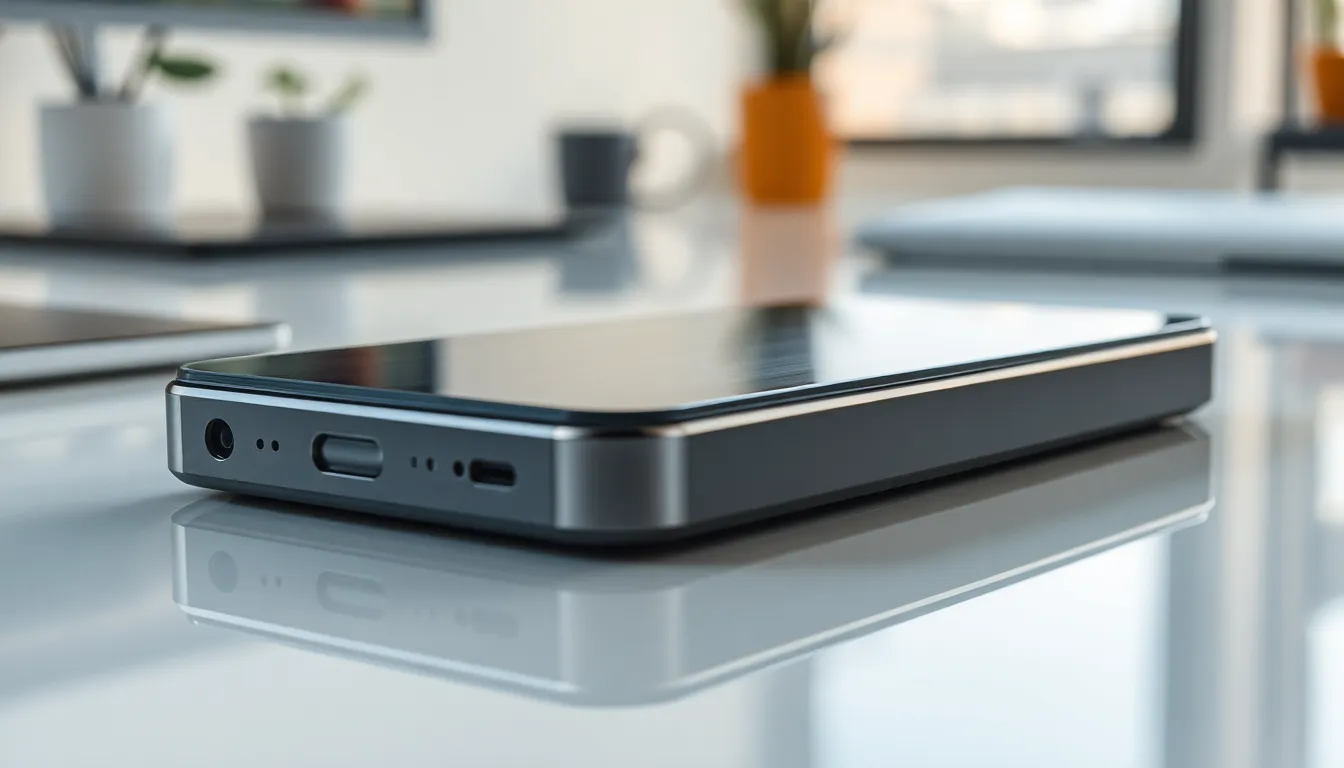In a world where gadgets seem to multiply faster than rabbits, titanium has emerged as the unsung hero of consumer electronics. This lightweight yet incredibly strong metal is revolutionizing how we think about durability and design. From sleek smartphones to high-tech laptops, titanium is making waves, and the archives of its applications are nothing short of fascinating.
Imagine a smartphone that can survive a drop from your pocket without a scratch—sounds like a dream, right? Thanks to titanium, that dream’s becoming a reality. Dive into the archives of titanium’s role in consumer electronics and discover why this remarkable metal isn’t just a trend; it’s the future. Whether you’re a tech enthusiast or just curious about what’s next, the stories hidden within these archives are sure to spark your interest and maybe even a chuckle or two.
Table of Contents
ToggleOverview of Titatnium Share Consumer Electronics Archives
Titanium’s role in consumer electronics has evolved significantly. This material’s outstanding strength-to-weight ratio makes it ideal for various applications in technology. Several manufacturers integrate titanium into smartphones, laptops, and tablets. These devices benefit from increased durability and resistance to wear.
Users notice that titanium devices can withstand everyday wear and tear better than those made from traditional materials. The lightweight nature of titanium enhances portability, making it easier for consumers to carry devices without compromising on sturdiness.
Research indicates that titanium’s oxidation resistance contributes to longer device lifespans. Many tech companies focus on this aspect, which allows for devices to maintain their aesthetic appeal over time. As a result, consumers enjoy products that remain functional and stylish.
Recent innovations showcase titanium’s versatility in design. Companies explore new finishes and colors, enhancing the visual appeal of their offerings. These advancements attract tech-savvy individuals seeking unique products that stand out in the market.
Moreover, the archives reflect a growing range of titanium-infused consumer electronics. Data from industry experts show that the use of titanium in this sector increases annually, driven by consumer demand for improved durability and functionality.
The continuous development of titanium technologies signals exciting possibilities for future electronic devices. Both manufacturers and consumers can anticipate remarkable advancements as the market adapts to these durable materials. The ongoing exploration of titanium’s properties leads to enhanced user experiences and satisfaction in the consumer electronics field.
Importance of Titatnium in Consumer Electronics

Titanium plays a crucial role in consumer electronics due to its desirable properties. Its lightweight and strong nature enhances the durability and design of modern devices.
Benefits of Titatnium
Durability stands out as a primary benefit. Titanium’s resistance to scratching and dents increases product longevity. Lightweight characteristics also improve user comfort and portability. Further, titanium’s oxidation resistance helps maintain the devices’ visual appeal, preventing corrosion and wear over time. Manufacturers incorporate innovative finishes, making products not only functional but also aesthetically pleasing. Enhanced thermal conductivity contributes to better device performance, allowing for efficient heat dissipation.
Market Trends and Demand
Growing consumer demand for durable electronics drives manufacturers to explore titanium applications. Industry reports indicate a significant rise in titanium utilization in smartphones, laptops, and tablets. Designers focus on sleek, modern aesthetics, attracting tech enthusiasts. Moreover, emerging trends highlight eco-conscious consumer preferences, prompting companies to adopt sustainable materials like titanium. Forecasts predict continuous growth within the market, with more brands likely to introduce titanium-infused products. Increased investment in research and development supports innovation, ensuring that consumer electronics evolve effectively in response to changing market dynamics.
Key Players in the Titatnium Share Market
Titanium’s influence in consumer electronics is expanding swiftly. Several key players are leading this evolution within the industry.
Leading Brands and Manufacturers
Apple, Samsung, and HP are prominent brands integrating titanium into their products. Each company leverages titanium’s strength and lightweight nature to create innovative devices. Apple’s use of titanium in the iPhone series enhances durability and aesthetics. Samsung’s laptops are increasingly adopting titanium to improve portability while maintaining robust performance. HP also emphasizes the material’s longevity, ensuring their devices stand out in a crowded market. These brands set industry standards, driving widespread adoption of titanium in consumer electronics.
Innovations and Technologies
Innovative technologies continue to emerge as more companies explore titanium applications. Manufacturers are experimenting with various finishes, enhancing both functionality and visual appeal. New processing techniques enable the production of thinner, lighter titanium components, which increases efficiency without sacrificing strength. Advanced designs, such as titanium enclosures for smartphones and laptops, reflect a commitment to quality. Growing attention to sustainable practices fuels the adoption of titanium, as it aligns with eco-conscious consumer preferences while offering superior benefits. These innovations position titanium at the forefront of technology advancements.
Analysis of Consumer Behavior
Consumer preferences in electronics reflect an increasing trend toward durability and design. Lightweight materials like titanium often captivate tech-savvy individuals, who seek high-performance devices. These consumers prioritize both functionality and aesthetics. The rise of titanium-infused products showcases an evolving market, driven by innovative finishes that appeal to diverse tastes. Eco-conscious individuals also value sustainable materials, further influencing purchase decisions.
Titanium’s impact on consumer choices is evident as it enhances product longevity and visual appeal. Research indicates that devices incorporating titanium tend to last longer and resist damage better than traditional materials. Consumers gravitate towards these products, drawn by their resilience and sleek designs. Manufacturers increasingly recognize the importance of incorporating titanium, aligning their offerings with changing market demands. Enhanced thermal conductivity contributes to improved performance, making titanium devices more desirable. Overall, the integration of titanium significantly shapes consumer preferences in the electronics market, fostering growing demand for durable products.
Future Outlook of Titatnium Share Consumer Electronics Archives
Emerging technologies are expected to significantly shape the future of titanium in consumer electronics. Forecasts indicate ongoing growth for titanium applications, driven by increasing consumer demands for durability and aesthetics. Companies are likely to continue innovating, creating thinner and lighter titanium components that enhance product appeal.
Recent market trends emphasize sustainability, with eco-conscious consumers influencing brands to adopt more environmentally friendly materials. Titanium’s eco-friendly qualities align with these values, prompting manufacturers to explore its full potential. The combination of strength and lightweight properties makes titanium an ideal choice for higher-end devices.
Ongoing investments in research and development play a crucial role in this evolution. Innovations in processing techniques open the door for new applications in design and functionality, enabling unique and attractive products. Prominent brands such as Apple and Samsung are at the forefront, actively incorporating titanium to improve durability while maintaining visual appeal.
Design versatility also stands out as a key factor in shaping future offerings. Titanium’s adaptability allows for a wider range of finishes and colors, catering to diverse consumer preferences. The growing interest in unique, stylish devices fuels demand for technologically advanced products.
Studies show that devices made with titanium exhibit enhanced resilience against wear and tear. Long-term benefits appeal to consumers seeking investments in quality electronics. As manufacturers align their strategic goals with evolving market trends, the future of titanium in consumer electronics looks promising, paving the way for innovative devices that prioritize durability and aesthetics.
Titanium’s role in consumer electronics is undeniably transformative. Its unique properties not only enhance durability but also elevate design aesthetics, catering to the demands of modern consumers. As manufacturers continue to innovate with titanium, the market is set to expand, offering a diverse range of stylish and resilient devices.
The trend toward sustainability further underscores titanium’s appeal, aligning with eco-conscious values that many consumers prioritize. This combination of functionality and visual appeal positions titanium as a key player in the future of technology. With ongoing research and development, the potential for titanium-infused products remains vast, promising exciting advancements in the consumer electronics landscape.




